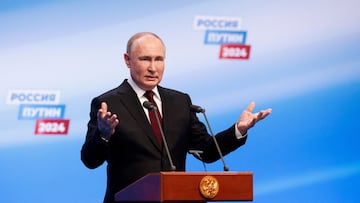How long has Vladimir Putin been the president of Russia? When does his new term end?
Though the validity of the elections remains in question, Russia held elections this weekend, with Presidnet Vladimir Putin landing another term as the Head of State.

The Russian Federation was born in 1991 when the Soviet Union dissolved, with Boris Yeltsin being the first president elected after the collapse. The federation’s early years were chaotic and full of financial hardship, and the economy experienced severe economic shocks as it moved from central planning to a ‘free market approach.’
This laid the groundwork for the rise of Vladimir Vladimirovich Putin, a former KGB officer, to become Yeltsin’s hand-picked successor when he stepped down. Terrorist attacks purported to be carried out by terrorists from a breakaway region of Chechnya gave the soon-to-be new president an excuse to quell the separatist movement there. It also gave Putin his first of two legitimate electoral wins.
Over the weekend, President Putin was elected in the 2024 Russian Presidential elections with 87 percent of the vote. International observers have raised concerns over the fairness of the polls. Still, with little ability to resist the repressive forces within the government, Putin will be inaugurated again in early May. The elections come as some Republicans block military assistance to Ukraine, giving Russian forces a major advantage on the battlefield... an advantage that they have not allowed to slip through their fingers, seizing territory and making serious damage across Ukrainian lines.
The rise of Vladimir Putin
In the mid-1980s, Vladimir Putin worked as a KGB officer in Dresden, East Germany. He was there when the Berlin Wall fell in 1989 and returned to the Soviet Union in 1990, shortly before its dissolution.
Upon returning to St Petersburg, his birthplace and formerly known as Leningrad, Putin joined the mayoral administration in 1991, headed by his former professor Anatoly Sobchak. During his time there, he established connections with different influential individuals, including the Russian Mafia and Oligarchs. These connections later became the foundation of his power.
After the Soviet Union’s disintegration, the economy was in turmoil, and the Oligarchs took advantage of their positions of power to gain control of various industries across the country. In a highly competitive environment, they created monopolies, which brought them immense wealth and control over the weak government struggling to transition from communism to a free-market economy. They used their power to control the nation’s resources, which ultimately resulted in widespread plundering of the nation’s wealth.
Putin becomes President
In 1996, when Sobchak lost the re-election, Putin moved to Moscow and joined the Yeltsin administration. Despite his relative obscurity, he quickly rose through the ranks and became part of the Presidential Staff within a year. In 1999, Yeltsin appointed him as the Prime Minister and his successor in the upcoming presidential elections. However, on New Year’s Eve, Yeltsin unexpectedly stepped down, making Putin the acting president of the Russian Federation.
Putin won his first presidential election in 2000, thanks to Russia’s successful campaign against the separatist movement in Chechnya. He won re-election in 2004, with an even larger majority of the vote. However, while consolidating his authoritarian power under the Russian constitutional democratic system, he encountered a glitch - term limits.
Putin gives up the presidency but holds onto power
Under the post-Soviet constitution, presidents could hold only two consecutive terms in office, but there was no limit to the number of terms in total. So Putin found a workaround by changing places with his First Deputy Prime Minister Dmitry Medvedev, who was elected president in 2008, becoming Russia’s third president. Conveniently, he proposed that whoever was elected in 2012 should have more time in office and extended the four-year term to six years.
Medvedev kindly proposed that Putin be the candidate for president in the 2012 election under a deal the two had previously worked out. Putin was elected once again to be president, technically Russia’s fourth, but there were widespread accusations of vote rigging. Not surprisingly, he won re-election in 2018, again under questionable circumstances after opposition candidates were sidelined.
Putin could be president until 2036
The constitutional changes in 2008 did not remove the two-term barrier that Putin would have encountered in 2024. So, in 2020, a barrage of constitutional changes was proposed, and tucked in among them was one that allowed him to serve two additional consecutive six-year terms.
Related stories
With his ruthless crushing of dissent and eliminating political opposition, barring some unforeseen occurrence, Vladimir Putin is dug in like an Alabama tick and will remain in office until 2036. Whether he chooses to leave then, by which time he’ll be 84 years old, he doesn’t have to worry about criminal prosecution, in Russian at least. In 2020, Putin signed a bill giving former presidents and their families immunity for anything they’ve done during their lifetimes.
After these most recent elections, President Putin will not face elections again until 2030, at which point he will be seventy-seven years old. The recent changes to the law would allow him to run again and serve until 2036.
Complete your personal details to comment